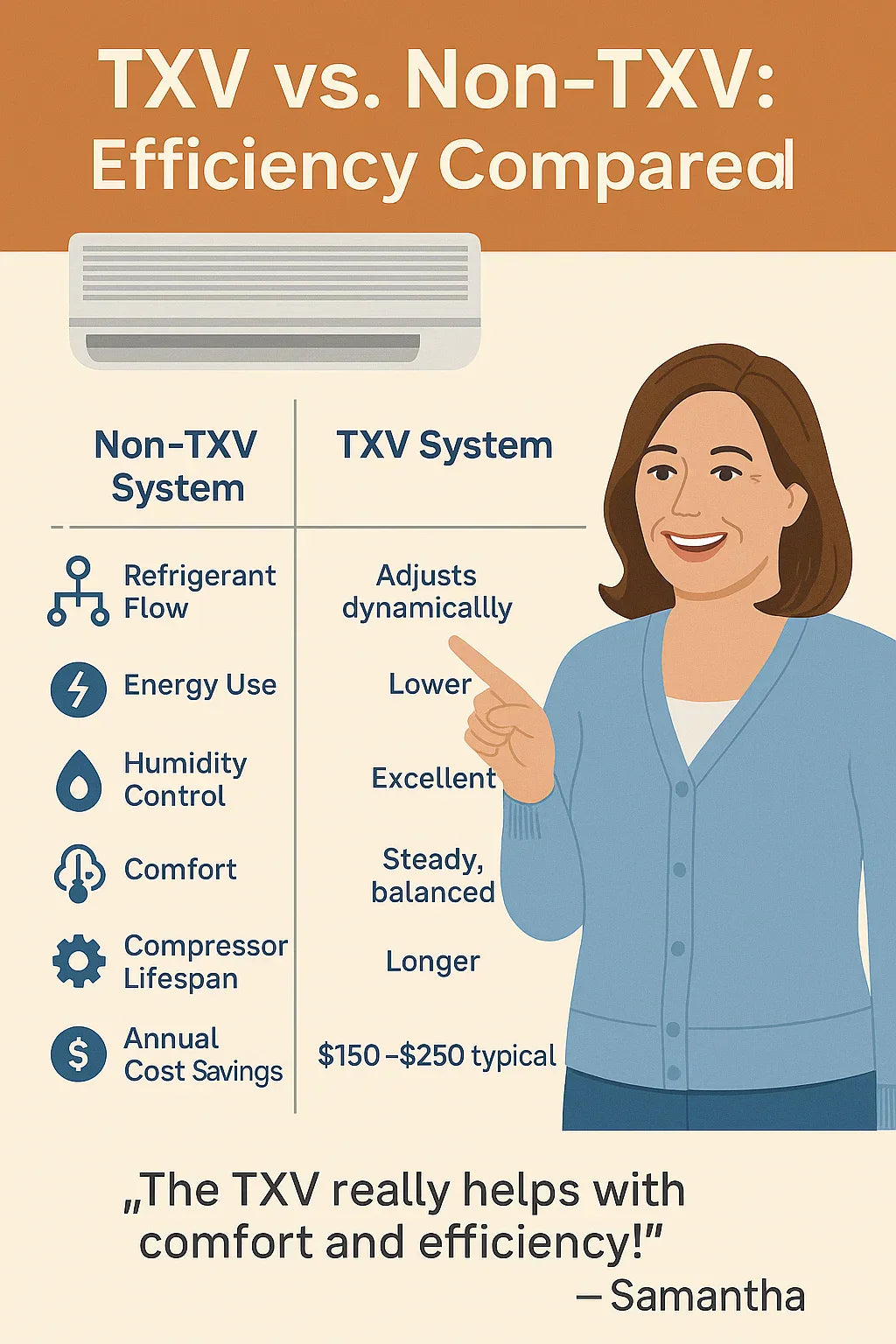When I first started looking into HVAC upgrades, I was overwhelmed by all the acronyms. One that kept popping up was TXV—short for thermal expansion valve. My Goodman 2 Ton R-32 Compatible Wall-Mounted Air Handler came with a factory-installed TXV, but I didn’t really understand what it did until I started living with it.
2 Ton Wall Mounted Goodman Air Handler - AWST24SU1305
Here’s what I found: that little valve makes a big difference.
In this guide, I’ll explain how Goodman’s wall-mounted air handlers with TXV technology perform in real-world conditions, how they improve comfort, and why they save money on energy bills.
⚡ Efficiency 101: What Air Handlers Do
Before we get into TXVs, let’s review what an air handler actually does:
-
Contains the blower fan that pushes conditioned air through your ducts
-
Houses the evaporator coil, where refrigerant absorbs heat
-
Provides backup heating (my Goodman has a 5 kW heater)
-
Works with your outdoor condenser or heat pump
Efficiency depends on how well the air handler and outdoor unit work together to control refrigerant flow, humidity, and airflow.
👉 According to the U.S. Department of Energy, improperly sized or poorly maintained air handlers can increase energy costs by 20–30%.
🔧 What a TXV Does (and Why It Matters)
A thermal expansion valve (TXV) regulates how much refrigerant flows into the evaporator coil.
-
Fixed orifice systems: Deliver the same flow regardless of demand. This often leads to overcooling in mild weather or undercooling on hot days.
-
TXV systems: Adjust dynamically. The valve opens or closes based on coil temperature and pressure, ensuring the system only uses the refrigerant it needs.
Why this matters:
-
Prevents the compressor from working too hard
-
Ensures consistent coil performance
-
Maximizes SEER2 efficiency ratings
-
Improves humidity control
👉 Energy Star confirms that TXV-equipped systems can achieve 10–20% higher efficiency than those without.
🌡️ Comfort & Humidity Control
One of the first things I noticed after installing my Goodman unit was how much more consistent my home felt.
Before:
-
Cold blasts of air when the AC kicked on
-
Humidity that lingered, even when the thermostat said 72°F
After:
-
Smooth, steady cooling
-
Noticeable drop in indoor humidity
In humid regions, the TXV is especially valuable because it allows the coil to stay cold enough to pull more moisture out of the air, making the house feel comfortable even at higher thermostat settings.
💰 Energy Savings with TXV Systems
So how much money can a TXV actually save?
-
TXVs reduce compressor cycling, which cuts down on wasted electricity.
-
They allow the system to reach its rated SEER2 performance (otherwise, you’re not getting what you paid for).
-
They prevent inefficiencies caused by refrigerant underfeeding or flooding.
Example:
-
A non-TXV 2-ton system may run at 13–14 SEER2 in real-world conditions.
-
A TXV-equipped Goodman system may operate closer to 15–16 SEER2.
-
Over a cooling season, that can mean $150–$250 in annual savings depending on your utility rates (DOE).
🏠 Goodman’s Design Choices
Goodman includes factory-installed TXVs in its R-32 compatible wall-mounted air handlers for three big reasons:
-
Future refrigerant compliance – With R-32 becoming standard, TXVs ensure compatibility and efficiency.
-
Installation reliability – Factory installation eliminates the risk of contractors mismatching metering devices.
-
Space-saving integration – Wall-mounted units are compact, so having a built-in TXV reduces add-on parts.
👉 HVAC.com notes that TXVs are now considered an industry standard for high-efficiency systems.
📊 Performance in Different Climates
How does a Goodman wall-mounted TXV system perform across regions? Here’s what I found:
Hot & Humid (Florida, Gulf Coast)
-
TXV keeps coil cold, wringing out humidity
-
Home feels cooler at higher thermostat settings (e.g., 75°F feels like 72°F)
-
Lower run times = bill savings
Dry & Hot (Arizona, Nevada)
-
TXV adjusts refrigerant flow to handle high outdoor temps
-
Faster cooldowns during peak heat waves
Temperate (Northeast, Midwest)
-
Smooth transitions between mild spring/fall days and extreme summer heat
-
Consistent indoor comfort across varying conditions
⚖️ TXV vs. Non-TXV Efficiency Comparison
| Feature | Non-TXV System (Fixed Orifice) | TXV System (Goodman Wall-Mounted) |
|---|---|---|
| Refrigerant flow | Constant | Adjusts dynamically |
| Energy use | Higher | Lower |
| Humidity control | Poor | Excellent |
| Comfort | Uneven temps | Steady, balanced |
| Compressor lifespan | Shorter | Longer |
| Annual cost savings | — | $150–$250 typical |
👩🏫 Samantha’s Real-World Take
When I compared my utility bills year-over-year after switching to the Goodman TXV-equipped unit:
-
My summer cooling costs dropped about 18%.
-
My home felt more comfortable, even with the thermostat set 2°F higher.
-
I had fewer “sticky nights” in July, thanks to better humidity removal.
Was it worth it? Absolutely. The TXV might seem like a small feature, but in practice, it makes a huge impact.
✅ Final Takeaway
So, how efficient is a Goodman wall-mounted air handler with TXV?
-
⚡ It maximizes your SEER2 performance
-
🌡️ It improves humidity control and comfort
-
💰 It saves $150–$250 annually on energy bills
-
🏠 It works across all climates, adjusting refrigerant flow as needed
👉 My advice: If you’re shopping for a new air handler, make sure TXV is on your checklist. Goodman’s wall-mounted R-32 compatible models come with it built-in, so you know you’re getting the performance you paid for.
In the next topic we will know more about: Noise, Space & Design: Will a Wall-Mounted Air Handler Fit Your Home Setup?







